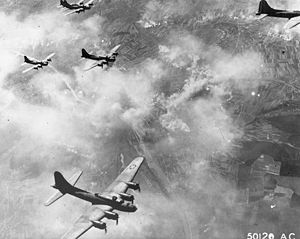Schweinfurt-Regensburg mission
| Schweinfurt-Regensburg mission | |||||||
|---|---|---|---|---|---|---|---|
| Part of Operation Pointblank | |||||||
 1st Bomb Wing B-17's over Schweinfurt, Germany |
|||||||
|
|||||||
| Belligerents | |||||||
|
|
|
||||||
| Commanders and leaders | |||||||
|
|
|
||||||
| Units involved | |||||||
|
|
|
||||||
| Strength | |||||||
| 376 B-17 bombers 268 P-47 sorties 191 Spitfire sorties |
Approx. 400 Bf 109, Bf 110, Fw 190 and other fighters | ||||||
| Casualties and losses | |||||||
| 60 bombers, 3 P-47s, and 2 Spitfires lost 58-95 bombers heavily damaged 7 KIA, 21 WIA, 557 MIA or POW |
25–27 fighters 203 civilians killed |
||||||
The Schweinfurt–Regensburg mission was an air combat battle in World War II. A strategic bombing attack flown by B-17 Flying Fortresses of the U.S. Army Air Forces on August 17, 1943, it was conceived as an ambitious plan to cripple the German aircraft industry. The mission was also known as the "double-strike mission" because it entailed two large forces of bombers attacking separate targets in order to disperse fighter reaction by the Luftwaffe, and was the first "shuttle" mission, in which all or part of a mission landed at a different field and later bombed another target returning to its base.
After being postponed several times by unfavorable weather, the operation, known within the Eighth Air Force as "Mission No. 84", was flown on the anniversary of the first daylight raid by the Eighth Air Force.
Mission No. 84 was a strike by 376 bombers of sixteen bomb groups against German heavy industry well beyond the range of escorting fighters. The mission inflicted heavy damage on the Regensburg target, but at catastrophic loss to the force, with 60 bombers lost and many more damaged beyond economical repair. As a result, the Eighth Air Force was unable to follow up immediately with a second attack that might have seriously crippled German industry. When Schweinfurt was finally attacked again two months later, the lack of long-range fighter escort had still not been addressed and losses were even higher. As a consequence, deep penetration strategic bombing was curtailed for five months.
Because of diversions of groups to the invasion of North Africa, the bomber force in England had been limited in size to four groups of B-17s and two of B-24s until May 1943. At that time, and in conjunction with the Pointblank Directive to destroy the Luftwaffe in preparation for Operation Overlord, the B-17 force had expanded fourfold and was organized into the 1st and 4th Bombardment Wings (which due to their large size would soon be re-designated Bomb Divisions). The 1st Bombardment Wing, which included all of the original B-17 groups, was based in the English Midlands while the 4th Bombardment Wing stations were located in East Anglia.
...
Wikipedia
